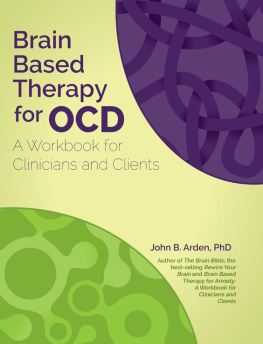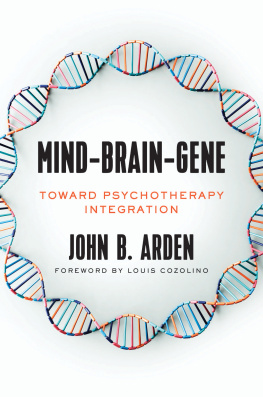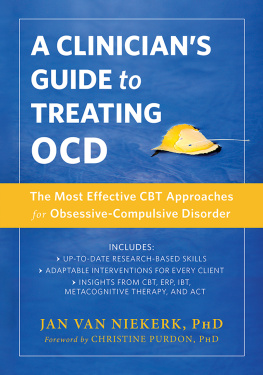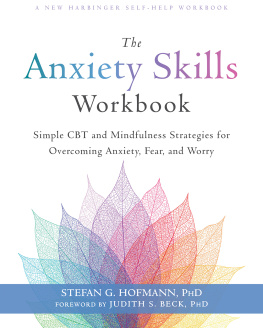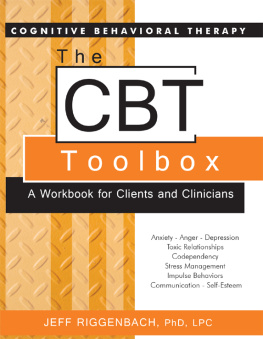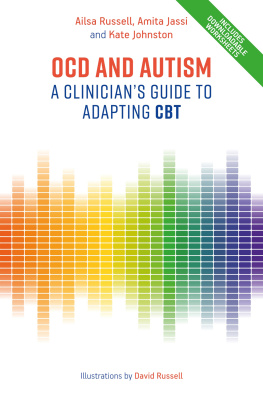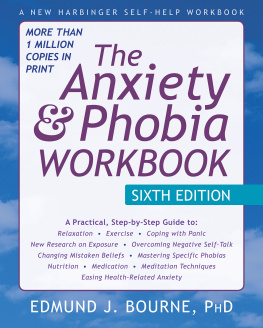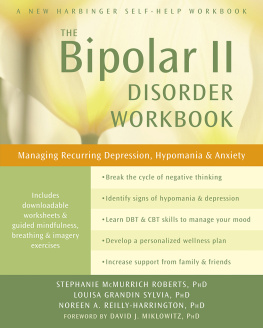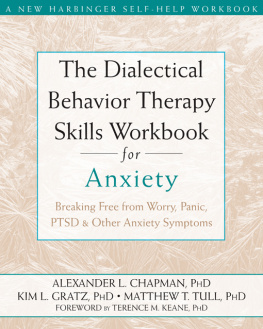BRAIN BASED THERAPY
FOR OCD
A Workbook for Clinicians and Clients
J OHN A RDEN , P H .D.,
Author of The Brain Bible and
Brain Based Therapy for Anxiety:
A Workbook for Clinicians and Clients
Copyright 2014 by John B. Arden Ph.D.
Published by
PESI Publishing & Media
PESI, Inc
3839 White Ave
Eau Claire, WI 54703
Printed in the United States of America
ISBN: 978-1-937661-23-6
All rights reserved. No part of this book may be reproduced or transmitted in any form or by any means, electronic or mechanical, including photo copying, recording, or by any information storage and retrieval system without the written permission from the author (except for the inclusion of brief quotations in a review).
Contents
Chapter 1
OCD Is Treatable!
Jonathan, a forty-one-year-old carpenter, loved running ever since competing on his high school track team. Now, however, he jogged thirty minutes each morning because he knew exercise was one of the best ways to keep his anxiety in check. After a good workout, his day generally went much smoother. But one autumn morning he noticed something on the road in front of a neighbors house just a block from his own home. The lawn was covered with dried fallen leaves and on the street where he was running there was a small patch of broken glass. A few steps past the glass Jonathan stopped. He was sure he had stepped on the glass. He quickly became certain that as he ran over the glass his shoe had kicked a shard into the leaves on his neighbors lawn. In the space of a few seconds, Jonathan constructed a frightening scenario that he couldnt get out of his mind. He imagined the sun shining through that shard, being focused and magnified until the leaves caught on fire. The fire spread, catching his own home on fire, killing his children.
Although Jonathan knew that scenario was highly improbable, he spent the next half hour searching his neighbors lawn for a piece of glass that wasnt there. He was obsessed with thoughts of danger and compelled to take action in order to reduce his fear. These types of intrusive and frightening thoughts were daily occurrences for Jonathan. He spent most of the day fighting against his compulsions to protect himself and others from highly implausible dangers that existed only in his imagination. His thoughts and actions seriously impacted his relationships with his wife and children. His wife was the only person he confided in until the problem became so severe that she insisted he seek professional help.
Obsessive-compulsive disorder (OCD for short) is a form of anxiety that comes in a variety of types and intensities. It is defined by repeated, intrusive, unwanted thoughts, called obsessions, often (but not always) about frightening things that are very hard to get out of ones mind. These thoughts are followed by actionseither physical or mentalthat are intended to reduce the uncomfortable, anxious feelings. These are called compulsions because people feel compelled to do them to relieve their anxiety.
Most people with OCD dont know what it is or that they have it. To make matters worse, many health care professionals are not trained to ask the right questions that will lead to diagnosis and treatment. To compound the problem even further, people with OCD are usually so confused or embarrassed by their symptoms that they dont tell anyone. This all adds up to a lot of unnecessary suffering.
If you think you might have OCD, there are three very important things you need to know right away. The first is that OCD is highly treatable! Let that sink in for a second or two. Yes, OCD is treatable with or without medication. This means that you really can feel better than you do today. If youre like a lot of people with OCD, you may have given up on feeling better or worry that youll have these same problems for the rest of your life. Second, some people are even afraid that because they have OCD it means theyre crazy. Thats just plain wrong! People with OCD are not crazy. OCD is highly treatable.
REWIRE YOUR BRAIN AND FEEL BETTER
Third, you need to understand that getting better comes down to rewiring a part of your brain that only learns by doing. Thats why the exercises in this book can be more effective than taking medicine to control your OCD. (Well talk more about medications for OCD later because there are definite pros and cons to taking them.) But like reprogramming a computer, you need to know something about how your brain works in order to undo the part that doesnt work. And were here to guide you in properly installing new and better instructions. Just remember, small steps lead to big results. As with programming a computer, it needs to be done in the right sequence. But dont worry, well lead you through the process step by step, and before long youll start seeing your progress because youll notice that you feel less anxious and more in control.
THE FIRST THING TO DO
Okay, lets get started with something simple that will begin building your repertoire of habits that will help you feel better. Simply stop for a few seconds and notice how anxious or uncomfortable youre feeling right now. What is your present state of comfort or discomfort?
Anxiety is measured in what are referred to as SUDs, which stands for subjective units of discomfort. On a scale of 1 to 100, how anxious or uncomfortable are you? Imagine that 100 means youre jumping out of your skin, you feel as if you cant take it another second, and 1 means youre relaxed, as if youve just woken up from the most delicious sleep imaginable. Assess how youre feeling at this moment and rate it 1 to 100.
Later, when you get into your individualized treatment program, well ask you to make a habit of recording your SUD score. But for now, just noticing and coming up with a number to measure your discomfort is enough. This sounds easy to do, and it is. But many people with anxiety in general and OCD in particular dont want to reflect on their level of discomfort. On the one hand, its natural to try to avoid something that might make us uncomfortable. On the other hand, however, avoiding things can make a problem bigger than it is. This is what happens with OCD.
Knowing what you are feeling is the beginning of your treatment. This ability is called interoception, meaning to feel your bodys inner sensations. Its important to know the reality of your anxiety rather than what you think it might be. Many people feel that theyre at a 100 all the time, and when they start paying attention and recording their actual SUD scores they find things arent nearly as bad as they thought. We all tend to remember the bad things more easily than the good. Well return to the subject of SUD scores later with more instructions on how to use them to measure your progress. But if you havent done so already:
Stop reading.
Close your eyes for a few seconds.
Sense how your body is feeling.
Rate your anxiety/discomfort from 1 to 100.
Excellent! You just began your treatment program.
HOW THIS BOOK CAN HELP YOU
Youll learn what OCD is and how you can treat yourself with a powerful treatment technique called exposure with response prevention. Ill explain why this treatment works and teach you how to use it. You will learn which behaviors lead to success, as we share with you examples of treatment plans for problems similar to yours.

